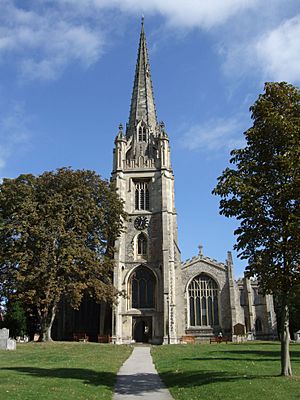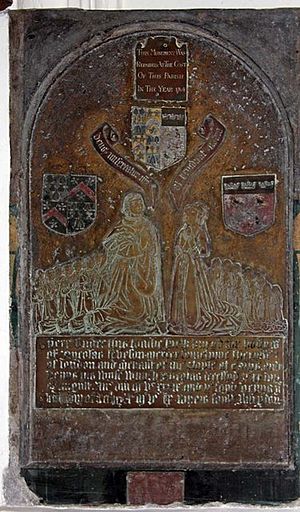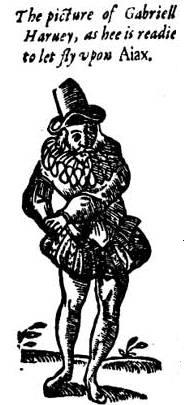Joan Leche facts for kids
Quick facts for kids
Joan Leche
|
|
|---|---|
| Born | c. 1450 |
| Died | March 1530 (aged 79–80) |
| Spouse(s) | Thomas Bodley Thomas Bradbury |
| Issue | James Bodley John Bodley Denise Bodley Elizabeth Bodley |
| Father | Denis Leche |
| Mother | Elizabeth (surname unknown) |
Joan Leche (born around 1450 – died March 1530) was a kind lady who gave money to good causes. She was married twice. First, she married Thomas Bodley. Later, she married Thomas Bradbury, who became the Lord Mayor of London in 1509.
Joan helped start a special place for prayers called a chantry in London. She also helped create a grammar school in Saffron Walden, Essex. Her family was quite important! Her great-grandson, Sir John Leveson, helped stop a big rebellion in 1601. Another great-grandson, William Leveson, helped manage the famous Globe Theatre where William Shakespeare's plays were performed.
Contents
Joan Leche's Family Background
Joan Leche was born around 1450. Her father was Denis Leche from Wellingborough, Northamptonshire. Her mother's name was Elizabeth, but her last name isn't known.
Joan had three brothers: Henry, Thomas, and John. Her brother John became a priest. He was the vicar (a type of church leader) of Saffron Walden, Essex, from 1489 until he passed away in 1521.
Her First Marriage to Thomas Bodley
Between 1470 and 1475, Joan Leche married Thomas Bodley. He was a successful businessman in London. He was a "citizen and Merchant Taylor," meaning he was a respected member of the city and part of the tailors' guild.
Thomas and his brother Richard lived in London. They were part of the same family as Sir Thomas Bodley, who later founded the famous Bodleian Library at Oxford University. They even had the same family coat of arms, which is like a special family symbol.
Joan's Children
All of Joan's children were from her first marriage to Thomas Bodley:
- James Bodley (died 1514). He became a "mercer," which means he sold fine fabrics. He lived in Saffron Walden and had two sons and a daughter.
- John Bodley (died by 1522). He became a Benedictine monk at St Albans Abbey.
- Elizabeth Bodley (died between 1526 and 1530). She married William Tyrrell. They had two sons and two daughters.
- Dionysia Bodley (died 1561). She was the youngest daughter. She married Nicholas Leveson, another wealthy London mercer. They had a very large family with eight sons and ten daughters, including three sets of twins!
- Their eldest son, John Leveson, was sadly killed in Kett's Rebellion.
- Their second son, Thomas Leveson (1532-1576), married Ursula Gresham. Ursula's father, Sir John Gresham, was also a Lord Mayor of London.
- Thomas and Ursula's son, Sir John Leveson (1555–1615), became famous for helping to stop the Essex rebellion in 1601.
- Another son, William Leveson (died 1621), was important for the Globe Theatre. He was one of the people who helped manage the shares for the theatre's owners, including the famous playwright William Shakespeare.
When Thomas Bodley died, he left a lot of money. Joan, as his wife, received a third of his wealth. It's thought that she might have continued running his business for a while.
Her Second Marriage to Thomas Bradbury
Around March 1495, Joan Leche married again. Her second husband was Thomas Bradbury (born around 1439 – died 10 January 1510). He was in his mid-fifties, and Joan was in her forties.
The Bradbury family came from Derbyshire and later moved to Littlebury, Essex. This town was near Saffron Walden, where Joan's brother was the vicar. Thomas Bradbury was a wealthy London mercer and a "Merchant Adventurer" (a merchant who traded overseas). He had never been married before. After they married, Joan's son, James Bodley, became an apprentice to Thomas Bradbury to learn the mercer trade.
After their marriage, Thomas Bradbury became more involved in public life. He was elected to Parliament in 1495. He also served as a warden for the Mercers' Company and was one of the Sheriffs of London in 1498. In 1502, he became the Master of the Mercers' Company and an alderman (a senior member of the city council).
Experts believe Joan's influence helped Thomas Bradbury get involved in these public roles. She likely managed his business while he was busy with city affairs. In 1509, he was chosen as Lord Mayor, but he died shortly after, on January 10, 1510. He was buried in St Stephen Coleman Street church. Joan and Thomas did not have any children together.
Thomas Bradbury left Joan a large house in London and other properties. He also left her his mercery business. It seems she sold the business after her son James Bodley, who was a mercer, died in 1514. James even named his mother as the overseer of his will and left her a pound of saffron as a thank you.
Joan's Later Life and Charitable Gifts
After Thomas Bradbury died, Joan used her wealth to help others. She set up a "perpetual chantry" at St Stephen Coleman Street church. This meant she bought lands, and the money from these lands would pay for prayers for her two husbands forever.
Within a year of Thomas Bradbury's death, Joan bought the necessary lands. She also agreed to give her large house in London to the Mercers' Company to use as their meeting hall. In return, the Mercers' Company agreed to manage the funds for the chantry. In 1511, Joan even asked the Mercers to hold their annual dinner at her mansion. She wanted "Company of Gentilwemen" (women) to be there, which was a new idea at the time! This tradition of having wives at the Mercers' banquet continued for several years.
Helping Saffron Walden
In 1513, Lady Bradbury, her brother John Leche (the vicar), and her son James Bodley helped the town of Saffron Walden gain some self-governance. They did this by starting the Guild of the Holy Trinity. Lady Bradbury also gave money to help repair the town's church.
After her brother, the vicar, died in 1521, Lady Bradbury decided to fulfill a dream he had: to open a grammar school in the town. Within a year, she found a schoolmaster and paid his salary herself. By 1525, she had set up a way for the school to be funded permanently.
One famous student at this school in the 1560s was the writer Gabriel Harvey. Another writer, Thomas Nashe, joked that Harvey was known for "stabbing with penknives" while at the school.
During her time as a widow, Lady Bradbury managed to double the money she inherited from Thomas Bradbury. She bought more properties, including lands that helped support her school in Saffron Walden. She made her last will on March 2, 1530, and died later that month. She was buried next to her second husband, Thomas Bradbury.
The special prayer place (chantry) that Dame Joan founded was later closed down by King Edward VI. However, some of the properties she owned are still managed by the Mercers' Company today. The school she founded in Saffron Walden is also still open and is now known as Dame Bradbury's School.




